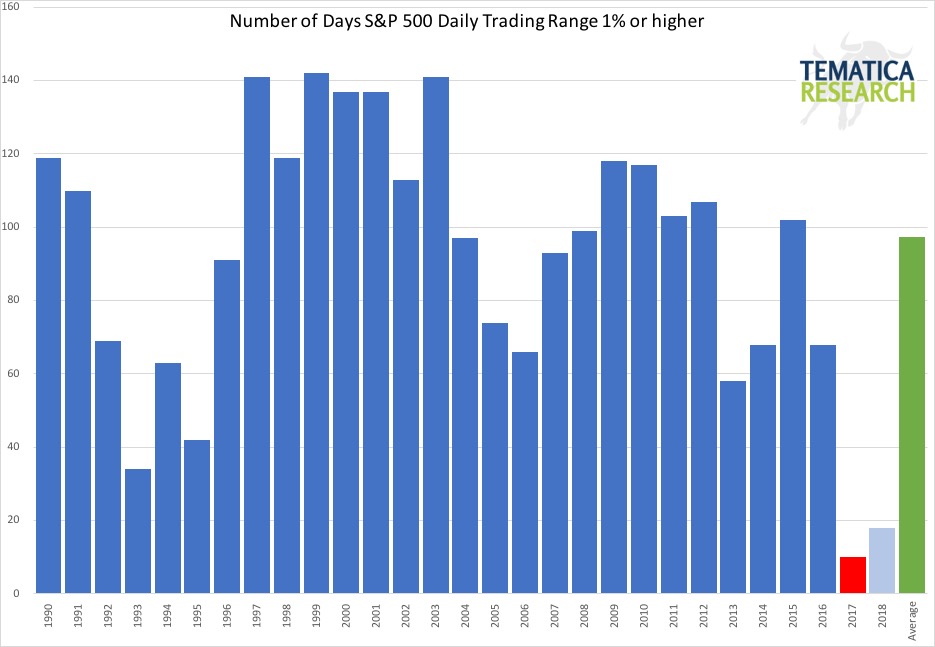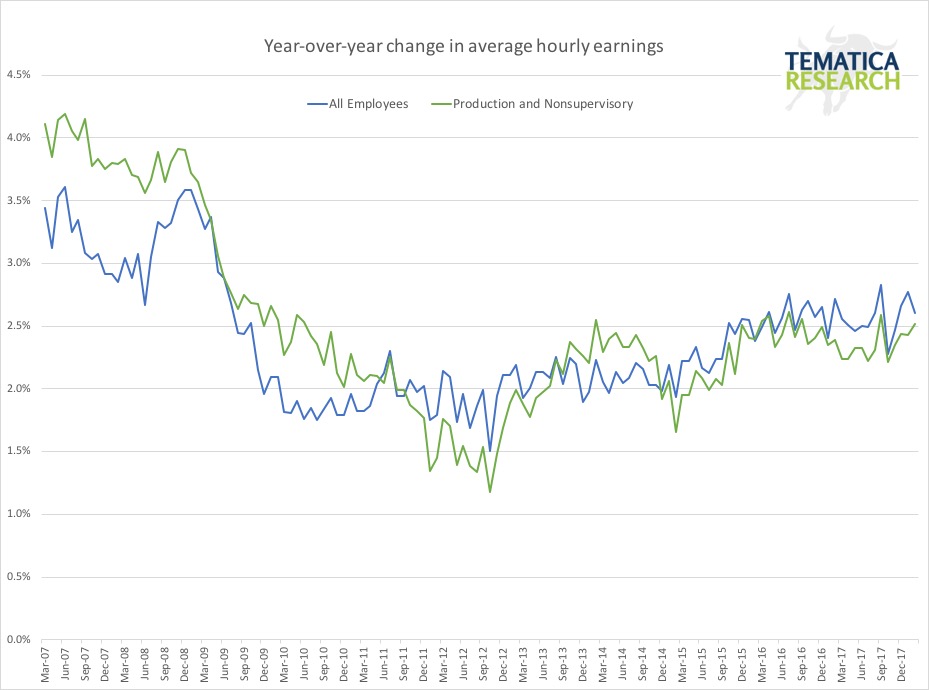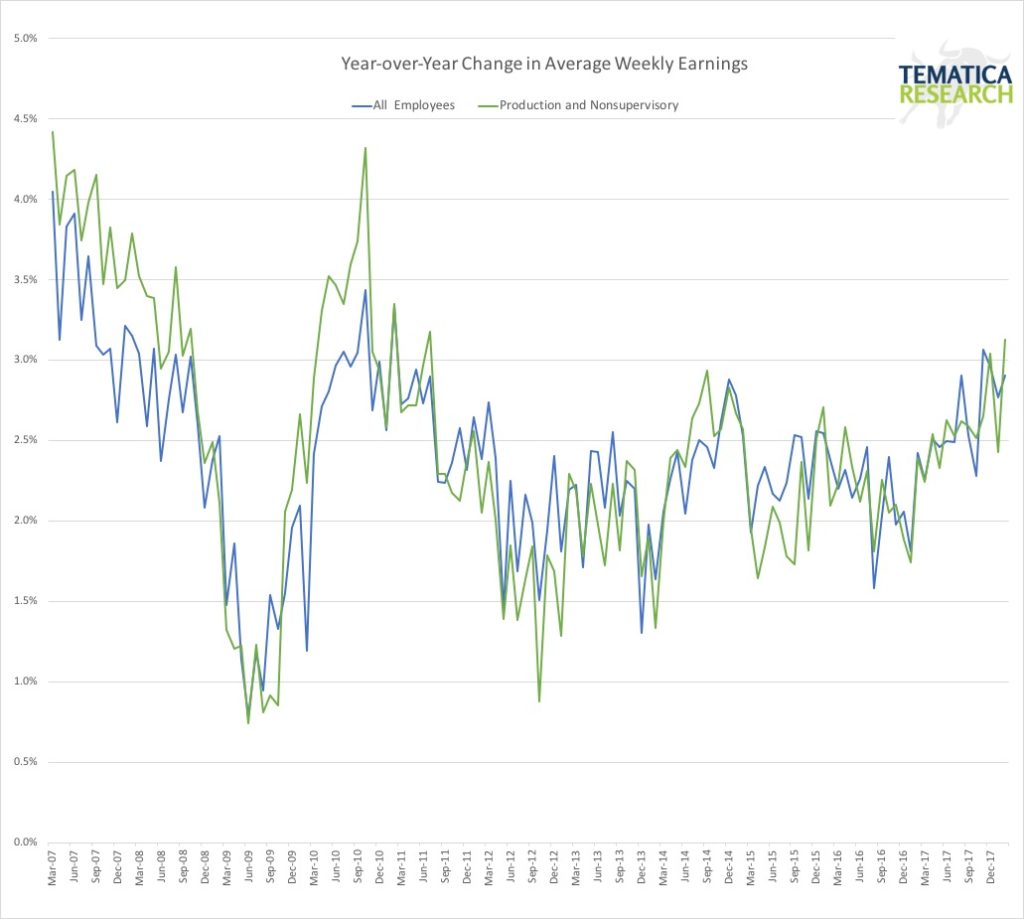WEEKLY WRAP: The Tortoise Economy vs The Hare Market
Happy Bull Market Birthday!
Today is the ninth birthday of this equity bull market, a rather impressive run that has generated roughly 5x in returns within an economy that has grown at a yawn-inducing pace. As the third longest bull market in history, this is an impressive day in an otherwise unimpressive week in the markets. Even as the market rallies on less toothy tariffs and a better than expected February Employment Report, there are reasons contained inside today’s jobs and wage report signaling the all clear on inflation has yet to arrive.
On Monday the major equity market indices started off on a downtrend but then shifted to a more risk-on tone during the day as the markets shrugged off last week’s tariff tantrum with the Trump Administration’s softer talk. The major U.S. equity indices rose over 1% on the day as the VIX, gold, and silver fell. The bullish tone on Monday saw 29 of the 30 Dow components ending the day in positive territory, with Nike (NKE) the only stock to lose ground on an otherwise very bullish day. Ironically, Nike, a contender for our Rise of the Middle-Class investment theme, has been one of the best performing Dow stocks since last October.
Monday once again saw the Utilities Sector (XLU) ETF lead all other sectors, which is not typical when the market is bullish, nor is it typical to see the 10-year Treasury yield close higher on a bullish day for equities. We’ve noted this odd occurrence a few times before in the Weekly Wrap, and the frequency of this contradiction has our attention as does the yield curve, which is once again flattening.
Tuesday the international markets were more bullish as participants became more skeptical of tariff talk. U.S. equities closed in the green, but the gains were more modest than Monday’s, while the dollar lost nearly 0.5%.
Wednesday the markets were mixed with the small cap Russell 2000 lead the pack, gaining 0.8% on the day, the Nasdaq up 0.3% while the S&P 500 declined nearly 1% early in the day, but rallied back to close down just 1 point. The Dow lost 83 points. The VIX remains elevated while the US Dollar looks to be unable to muster momentum for a bullish breakout.
Thursday the S&P 500 closed just shy of its 50-day moving average, having been below this metric since late February, as buying towards the close pushed stocks higher on rising volume. The President’s speech at 3:30 PM ET revealed that Canada and Mexico would be exempted from the tariffs on aluminum and steel while the NAFTA talks continue, and he hinted that he may be willing to be more flexible than he had previously indicated. The upward move towards the end of the day in the major equity indices and the 6% drop in the VIX indicate that the market’s fears from last week have been mollified. It is looking like Tematica’s Chief Investment Officer, Chris Versace, nailed it this week when he said this whole thing is likely a negotiating tactic right out of Trump’s Art of the Deal book in our weekly Cocktail Investing podcast.
As of Thursday’s close, the S&P 500 and the Russell 2000 were both up 2.4% year-to-date with the Nasdaq up a more impressive 7.6%. Even so, the S&P 500 remains 4.7% below its January high, the Russell 2000 2.2% below its and the Nasdaq down just 1.0% from its high.
Despite the relative calm on Thursday, volatility has returned with the number of days the S&P 500 has traded in a 1% or greater range in 2018 already nearly double what we experienced in 2017. The chart below puts the anomaly of 2017 in perspective. The number of 1% days in 2017 was roughly 1/10th the annual average between 1990 and 2016!

Economy
This week the economic news was generally pretty good after having had more misses than beats since the start of the year when it comes to the hard data reports.
The ISM’s Non-Manufacturing composite declined from January’s 59.9 to 59.5 in February but still beat expectations for 59.0. To put this figure in perspective, this is the third strongest reading since August 2005. On a year-over-year basis, 7 subsectors rose while just 3 declined. New Orders were up on both a month-over-month and year-over-year basis, as were backlog orders. The employment measure, however, saw its biggest month-over-month decline since February 2014. Given the strength we saw in Thursday’s ADP report, (more on that later) this is likely just a reversion to the mean from the big jump we saw in the Employment index in January. The Prices Paid component if the ISM report also declined, falling from 61.9 in January to 61.0 – no big inflationary pressures evident in at least this month’s report.
One area in which we are not seeing increasing pricing pressure has been with gasoline prices. Year-to-date prices have risen just 1.6%, which is well below the average year-to-date change of 7.2%, going back to 2005. The average price of $2.53 per gallon (as of 3/6) is also below of average price at this point in the year of $2.74.
The employment data this week was overall very strong. Wednesday’s ADP Private Nonfarm Payroll report showed much stronger payroll growth than expected, rising to 235,000 versus 200,000 expected. There were gains in both the Goods-Producing and Service-Providing sub-sectors, up 37,000 and 198,000 respectively. In fact, the only industry sector that experienced declines was Information, losing 1,000.
The stronger-than-expected 2.5% increase in Unit Labor Costs quarter-over-quarter, versus 2.1% expected confirms the strength of the ADP report and the continuing commentary from business on the challenge of finding the right talent to fill open positions. Initial unemployment claims came in at a 231,000 versus the 220,000 expected, rising from last week’s 48-year low, while job cuts announced by U.S. based employers fell 20% in February.
The big news came on Friday with the nonfarm payroll report which had the economy adding 313,000 jobs versus expectations for 200,000. The market sighed with relief to see the year-over-year average hourly earnings for all employees slowed to 2.6% after last month’s 2.8% pace. For the Nonsupervisory and Production employees, the rate rose slightly to 2.5% from 2.4% last month.

To sum it up succinctly, the February Employment report was a Goldilocks report, at least that’s what much of the mainstream is reporting. We dug into the data a bit more though and found something that should get the attention of those concerned with rising inflationary pressures. Average weekly earnings on a year-over-year basis for both the All Employees category and the Production and Nonsupervisory categories increased over the month. The All-Employee category isn’t too concerning as it rose to 2.9% from 2.8% in January but is still down from the 3.0% pace in December 2017 and 3.1% in November 2017. The concern data point is the 82% of the workforce in the Production and Nonsupervisory category that saw average weekly earnings rise 3.1%, up from 2.4% in January.

Is this the start of more powerful wage pressures?
One month does not make a trend, but the Production and Nonsupervisory group has seen average weekly earnings on a year-over-year basis increase by 3% or more in 2 of the past 3 months. The last time we saw a 3 handle was in July 2011.
This week’s Weekly Wrap started with the Bull Market Birthday performance in contrast to the weak economic recovery. The past 8 bull markets have seen a median annual return of 17.3% for the S&P 500 amidst median nominal GDP growth of 7.3% and real GDP growth of 3.8%. While the performance of the S&P 500 is right on track in this bull run at 17.3%, nominal GDP growth has been a meager 3.6% (less than 50% of the median) and real GDP a miserable 2.1% (55% the median). Imagine if the stock market performance had been more in line with the economy. Perhaps equity investors ought to send some sort of collective gift basket to the world’s central bankers.
The bottom line for the week is the stock market looks to have stabilized for now on the hopes that Trump’s actual tariffs will be a tad less tortuous than the tone of his previous weekend tweets. While the market’s knee-jerk reaction to this month’s jobs report was positive, we see rising wage pressures and suspect those fellows over at the Fed are noticing the same. While we see a lot of headwinds to inflation from a long-term secular perspective, the near-to-medium term forces are rising. Investors would do well to assess their portfolio’s sensitivity to rising rates.

